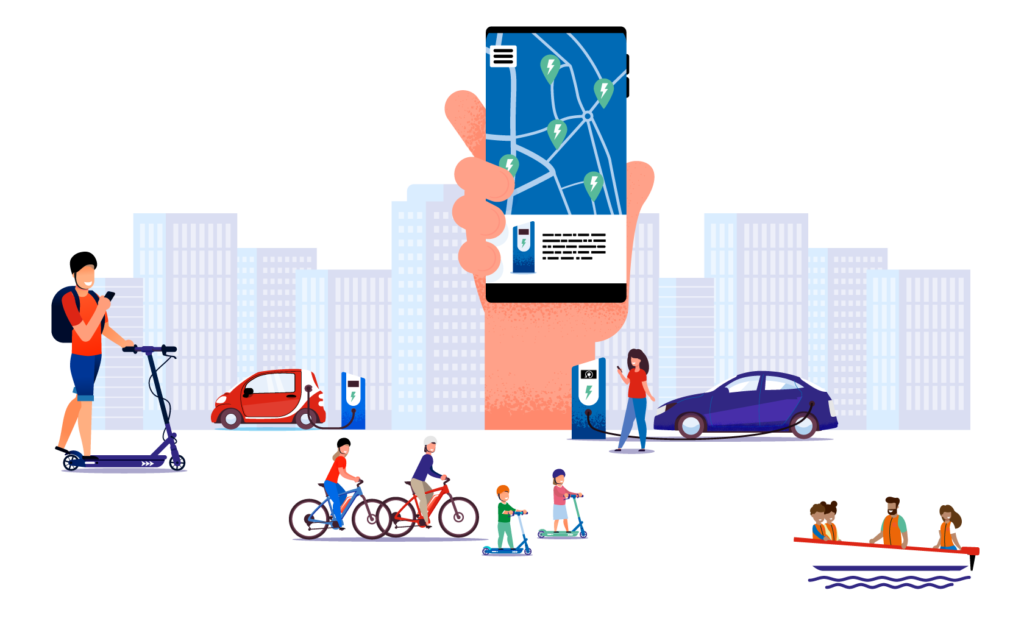Move sustainably
Everyday electric vehicle mobility
See charging points and other tips for electric cars in Helsinki.
Everyday electric vehicle mobilityShared-use vehicles
Vehicle sharing is a convenient option in the urban environment. See the range of services available in Helsinki here.
Shared-use vehiclesIncentives for citizens
Discounts, subsidies and other benefits that encourage sustainable mobility.
Incentives for citizensThe city is committed to promoting low-emission and carbon-neutral mobility. Transport and traffic cause approximately one quarter of Helsinki’s greenhouse gas emissions. Car traffic also degrades air quality and causes noise pollution in the city.
We want to make sustainable mobility increasingly easier for Helsinki residents. Choosing public transport, cycling and walking benefits not only your own health but also the health of fellow Helsinki residents – and helps to reduce the environmental impacts of car traffic. Good air quality and a pleasant sound environment also improve the general well-being and comfort of residents.
When there is a need for using a car, we encourage citizens to choose an electric or low-emission vehicle. However, it is not possible to achieve Helsinki’s emission reduction targets by electric cars alone or by favouring alternative fuels. Wider changes in mobility habits are needed, with sustainable mobility and mobility as a service playing an increasing role in this, and reducing the need to own a car.

What impacts do my mobility choices have?
Climate
- The city of Helsinki aims for carbon neutrality by 2030. In the transportation sector, this means that carbon dioxide emissions should fall by 69% from 2005 levels.
- Traffic currently accounts for about 23% of Helsinki’s total CO2 emissions. Most of these emissions are produced by passenger cars.
- The city promotes both the share of sustainable modes of transportation and the electrification of transport. Both themes are also in the city’s strategy.
- In addition to the actions of the city, citizens can easily influence transport emissions through their own choices, for example, by favouring sustainable modes of transport, reducing private car use or choosing a low-emission vehicle.
Air quality
- The air quality in Helsinki has improved over the last few decades and it is fairly good at an international level. But still, air pollution sometimes degrades air quality in Helsinki as well. Traffic exhaust fumes and street dust degrade the quality of the air we breathe the most because they are discharged close to the height we breathe in.
- Helsinki aims for a low-emission transportation system and a reduction in emissions that are harmful to health. The city promotes better air quality with the Helsinki Air Quality Plan 2017–2024.
- The residents can have an impact on air quality by favouring sustainable mobility and choosing friction tyres for their vehicles, as they have been proved to reduce the formation of street dust.
Noise
- Environmental noise is a significant factor that lowers the quality and comfort of the living environment in Helsinki. Continuous loud noise may also cause health hazards. Road traffic is the primary source of harmful noise in Helsinki. 39% of the residents of Helsinki live in areas where the noise level caused by road traffic exceeds the limit value of 55 dB during the day.
- The city aims for a low-emission transportation system and a reduction in emissions that are harmful to health. The noise abatement efforts by the City of Helsinki are directed by the Noise Abatement Action Plan for 2018–2022. It contains measures related to city planning, affecting the noise source and structural noise abatement, among other things.
- The residents can have an impact on the comfort of the sound environment by favouring sustainable ways of moving.
Congestions and urban space
- Sustainable mobility frees up urban space and reduces congestion. Instead of wide car streets and parking squares, the city space will provide more space for walking and cycling. In addition, the urban environment will be greened, enlivened and made more comfortable.
- City and transport planning can influence how you move around the city. In addition, the city is involved in the strategic MAL (land use, housing and transport) planning for land use, housing and transportation in the Helsinki region, which outlines long-term sustainable solutions.
Microplastics
- Road transport is the largest single source of microplastics. Microplastics are especially released from car tyres. Ploughed city snow is also a significant source of microplastic.
- Transport plastics end up in the Baltic Sea with rainwater. The effects of microplastics on the environment are not yet entirely known. However, it has been found to be harmful to marine micro-organisms and to accumulate in the food chain. The plastic is impossible to remove once it gets in the ocean. Like any other plastic, its degradation in the environment is very slow.
- The city is reducing the production of microplastics by developing public transportation and especially rail traffic.
- Citizens, on the other hand, can have an impact on the emissions by paying attention to driving that saves tyres and by choosing friction tyres over studded tyres in winter.
